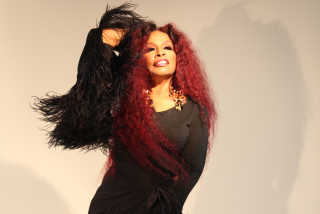Tal Farlow Still a Be-Bopper After All These Years : Music: Beat lives on in guitarist who just ‘hit the big 7-0.’ He’s never fought for the spotlight but enjoys international respect.
- Share via
Tal Farlow virtually epitomizes the ‘50s definition of cool . Lean and laid-back, with a Lincolnesque calmness that belies the surging energy of his guitar playing, he is a hardy survivor of a group of be-boppers who typified the jazz experience for the Beat Generation.
At 70, Farlow--who makes one of his rare Southern California appearances tonight) with the Pete Jolly Trio at the Hyatt Newporter--is as wryly laconic as ever.
“I’m always amazed when people say they’ve been influenced by my music,” he said during a phone conversation from his New Jersey home earlier this week.
“I suppose one of the reasons is because there just weren’t so many guitar players around when I got started. Barney Kessel, Herb Ellis, Chuck Wayne, Remo Palmieri, Johnny Smith--I’m probably leaving some names out--are the major guys who were around then. But today, there seem to be thousands of guitar players, so it’s no surprise that there are quite a few good ones.”
Typically, Farlow is exceedingly modest about his own playing. He continues to describe himself as “still a be-bopper,” but he has always managed to stretch the limits of that difficult style.
Quick and articulate, with machine gun-rapid melody lines and crisp chording, his playing in the ‘50s brought a vigor and excitement to the electric guitar that hadn’t been heard since the startling work of Charlie Christian more than a decade earlier.
“Everybody in my generation was influenced by Christian,” Farlow said. “I remember listening to him on the radio when I was a teen-ager in North Carolina. And when he came out with those first electric guitar solos I was really impressed.
“It wasn’t just the fact that the amplification made the guitar like a new instrument. It was that Christian used it in a way that liberated the guitar from a corner of the rhythm section and brought it right up front to play with the trumpets and the saxophones. I liked that a lot.”
Despite the almost universal respect for his playing among musicians, Farlow has never become a jazz name with significant marquee value. In part, his relative obscurity traces to his own reticence to push his career; in part, it reflects his discomfort with the more commercial aspects of the jazz world. For a substantial period in the ‘60s and ‘70s, his music was placed on the back burner while he made a living as a sign painter.
“I know people sometimes find it strange,” said Farlow with a chuckle, “but the truth is that sign painting is really the field for which I had some training. Music was sort of a hobby--I never did study it.”
Since the early ‘80s, however, Farlow’s music has become his primary focus. Although he has produced few recordings (“I’m not a frequenter of recording studios”), he tours regularly--especially in Europe, where he has achieved near-legendary status--teaches, and works at a network of clubs in the metropolitan New York-New Jersey area.
“I guess you could say I’m doing pretty much what I want to do, right now,” Farlow said. “I suppose I really should do some recording, and I’ll be looking into that.”
“I hit the big 7-0 three weeks ago, and I’m feeling just fine. So, with any kind of luck, I guess you’ll be seeing me around for a while.”
Tal Farlow plays at 6:30 p.m. at the Hyatt Newporter, 1107 Jamboree Road, Newport Beach. Admission: $6 to $7. Information: (714) 729-1234.
More to Read
The biggest entertainment stories
Get our big stories about Hollywood, film, television, music, arts, culture and more right in your inbox as soon as they publish.
You may occasionally receive promotional content from the Los Angeles Times.









